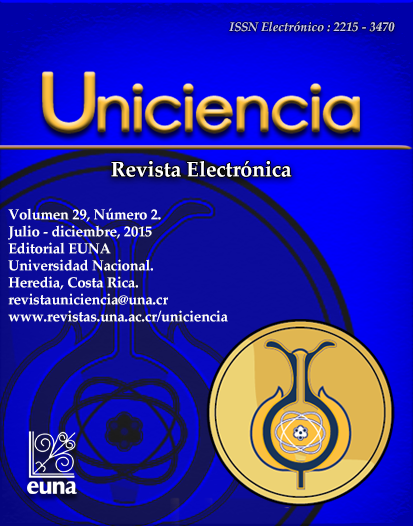Online GNSS processing as alternatives to different geodetic applications
DOI:
https://doi.org/10.15359/ru.29-2.1Keywords:
GNSS processing online, SIRGAS, GNSS, APPS, CSRS, AUSPOS, OPUS, SOPACAbstract
In this study a description in terms of utilization, throughput, file types and results of a series of online programs for GNSS data processing is done. At present the information that can be obtained from the GNSS systems, allows a diverse range of applications, from vehicle navigation to different studies related to terrestrial dynamics. The possibilities for use in geodesy rely exclusively on high accuracy that can be obtained by making the processing of GNSS data for scientific programs such as GAMIT and Bernese or a relative or differential work. However, they have developed a number of programs available online that provide a very suitable option for obtaining, in a short time solutions with acceptable accuracy for many tasks related to mapping, surveying, cadastre and geodesy. Some of these programs are based on technique Precise Point Positioning (PPP). The comparative study looked at a number of observation files in RINEX format were processed online programs APPS, CSRS, AUSPOS, OPUS and SCOUT. The results were analyzed in comparison with themselves, high accuracy positions given by Geocentric Reference System for the Americas ( SIRGAS ) ETCG station in addition to contemplate different satellite orbits files and processing mistakes online. Respect to alignment of the solutions according to the international framework lowest values were measured at 20 mm in the horizontal part.
References
Ebner, R. y Featherstone, W. E. (2008). How well can online GPS PPP post-processing services be used to establish geodetic survey control networks?[Qué tan buenos pueden ser los servicios en línea GPS-PPP de post proceso para establecer redes de control para mediciones geodésicas]. Journal of Applied Geodesy, 2. 149–157. doi: http://dx.doi.org/10.1515/JAG.2008.017
Ghoddousi-Fard, R. y P. Dare. (2006). Online GPS processing services: an initial study. [Servicios de procesamiento GPS en línea: un estudio inicial]. GPS Solutions 10. 12–20. doi: http://dx.doi.org/10.1007/s10291-005-0147-5
Huang C., Hu X.G., Chen Z.Y. (2002). Solution of Regional GPS Network using Precise Point Positioning with Undifferenced Data.[Solución de una red GPS regional usando Posicionamiento Preciso de Punto con datos sin diferenciar]. Chinese Astronomy and Astrophysics, 42(3), 248-258.
Kouba, J. y Héroux, P. (2000). GPS Precise Point Positioning Using IGS Orbit Products.[Posionamiento de Punto Preciso usando los productos orbitales del IGS]. Geodetic Survey Division. Natural Resources Canada.
Moya, J. (2010). Implementación del Servicio de Datos GPS de la Escuela de Topografía, Catastro y Geodesia. Revista Uniciencia, 24(1), 53-61.
Moya, J., Bastos, S., Rivas, M. J. y Gamboa, G. (2014). Evaluación del comportamiento cinemático de una serie de estaciones del Sistema Geocéntrico para las Américas procesadas con Precise Point Positioning en línea. Revista Uniciencia. 28(1), 2-19.
Wang, G. Q. (2013). Millimeter-accuracy GPS landslide monitoring using Precise Point Positioning with Single Receiver Phase Ambiguity (PPP-SRPA) resolution: a case study in Puerto Rico. [Exactitud milimétrica en el monitoreo de desplizamientos usando posicionamiento de punto preciso con solución de ambigüedades de fase de receptores de una frecuencia: un caso de estudio en Puerto Rico]. Journal of Geodetic Science, 3(1), 22-31. DOI http://dx.doi.org/10.2478/jogs-2013-0001
Downloads
Published
Issue
Section
License
Authors who publish with this journal agree to the following terms:
1. Authors guarantee the journal the right to be the first publication of the work as licensed under a Creative Commons Attribution License that allows others to share the work with an acknowledgment of the work's authorship and initial publication in this journal.
2. Authors can set separate additional agreements for non-exclusive distribution of the version of the work published in the journal (eg, place it in an institutional repository or publish it in a book), with an acknowledgment of its initial publication in this journal.
3. The authors have declared to hold all permissions to use the resources they provided in the paper (images, tables, among others) and assume full responsibility for damages to third parties.
4. The opinions expressed in the paper are the exclusive responsibility of the authors and do not necessarily represent the opinion of the editors or the Universidad Nacional.
Uniciencia Journal and all its productions are under Creative Commons Atribución-NoComercial-SinDerivadas 4.0 Unported.
There is neither fee for access nor Article Processing Charge (APC)






